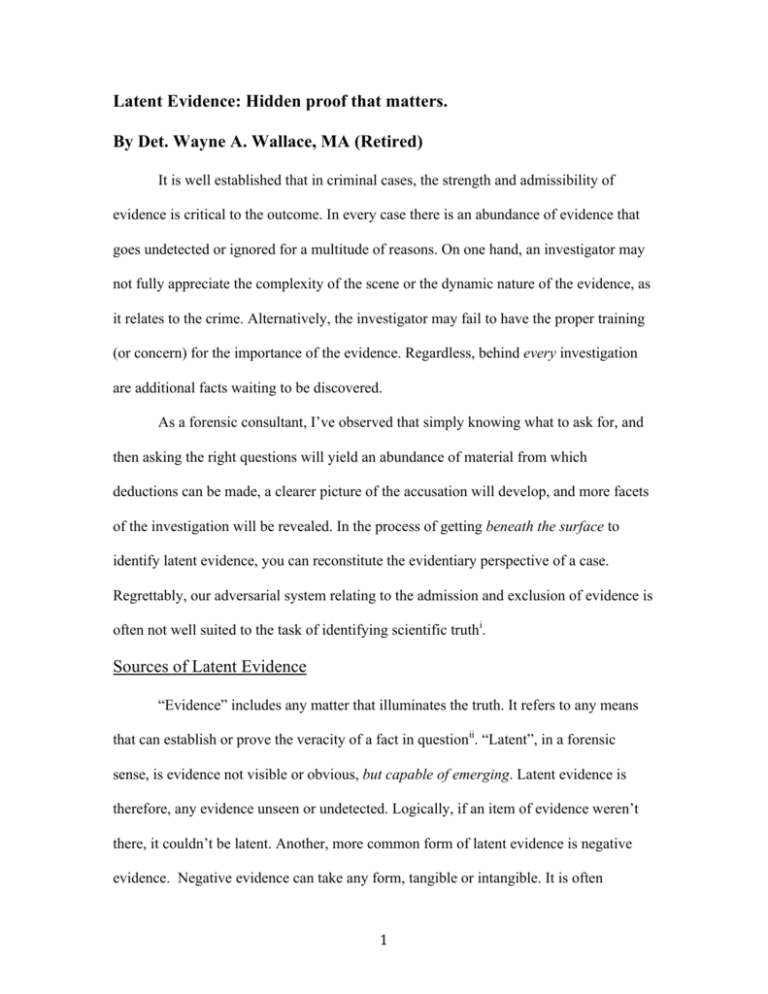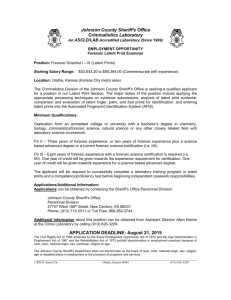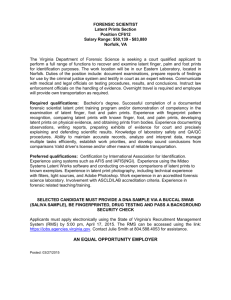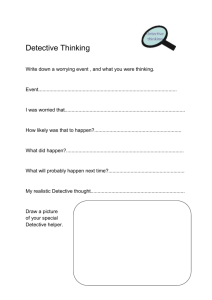Latent Evidence - forensiccriminologist.com
advertisement

Latent Evidence: Hidden proof that matters. By Det. Wayne A. Wallace, MA (Retired) It is well established that in criminal cases, the strength and admissibility of evidence is critical to the outcome. In every case there is an abundance of evidence that goes undetected or ignored for a multitude of reasons. On one hand, an investigator may not fully appreciate the complexity of the scene or the dynamic nature of the evidence, as it relates to the crime. Alternatively, the investigator may fail to have the proper training (or concern) for the importance of the evidence. Regardless, behind every investigation are additional facts waiting to be discovered. As a forensic consultant, I’ve observed that simply knowing what to ask for, and then asking the right questions will yield an abundance of material from which deductions can be made, a clearer picture of the accusation will develop, and more facets of the investigation will be revealed. In the process of getting beneath the surface to identify latent evidence, you can reconstitute the evidentiary perspective of a case. Regrettably, our adversarial system relating to the admission and exclusion of evidence is often not well suited to the task of identifying scientific truthi. Sources of Latent Evidence “Evidence” includes any matter that illuminates the truth. It refers to any means that can establish or prove the veracity of a fact in questionii. “Latent”, in a forensic sense, is evidence not visible or obvious, but capable of emerging. Latent evidence is therefore, any evidence unseen or undetected. Logically, if an item of evidence weren’t there, it couldn’t be latent. Another, more common form of latent evidence is negative evidence. Negative evidence can take any form, tangible or intangible. It is often 1 disconfirmatory in nature, and may or may not be exculpatory, but it is certainly helpful in assembling proof for reasonable doubt. To identify evidence beneath the surface, one must employ critical thinking, reasoning, and logical analysis. “Discovery” generally consists of an envelope containing paper copies that represent the facts and circumstances constituting the evidence used to support a criminal charge against a particular defendant. That evidence can be classified as physical (relevant, material evidence like scientific proof), demonstrative (circumstantial), documentary (paper evidence) or testimonial (witness statements). The challenge then, is to analyze and interpret what evidence is relevant. Honest dialogue concerning discovery and evidence presupposes the right of the defendant to know everything that the government intends to use against him, and also that the defendant receive full and truthful responses to inquiries about the investigative process. Because the innate nature of evidence is equivocal, the context in which the evidence was obtained will help to determine its relevance. For example, a gun by itself means nothing, but under the driver’s seat of a defendant’s car it becomes a concealed weapon. In my experience as a detective, both at a police department and the prosecutor’s office, defense attorneys customarily accepted discovery without question, and typically without much skepticism. The reality is that just because a prosecutor put together a packet of evidence, does not mean that is all the evidence that exists, nor does it obviate the need for close scrutiny of the evidence that was collected. If you weren’t going to accept the government’s analysis of the facts, why would you accept their analysis of the evidence? 2 Reports are the most obvious source of evidence as they should represent the who, what, when, where, why, and how of an incident. Reports should be comprehensive, but it is impossible to record every sense of every officer on paper, and even the slightest omission can lead to unidentified or additional facts. Therefore, counsel should obtain the identity of all officers conducting interviews and recordings of those interviews. For instance, a casual witness statement mentioned in a report indicates an interview was conducted. One question to ask about that interview would be, did that witness see something different, or perhaps nothing at all? Dispatch records can yield an abundance of material. Every responding officer should be accounted for in a comprehensive analysis. An inquiry directed to each could result in a report, photograph, or even a witness with a contrary statement. Evaluating Latent Evidence The most effective way to evaluate evidence is through an equivocal forensic analysis that reviews the entire body of evidence in a case, questioning all related assumptions and conclusionsiii. Evidence can be ambiguous and subjective in its interpretation, and, a myopic investigative approach often results in a singular, confirmatory theory of the case. Here, conclusions are often predicated on the quality of work done early in the case. It is not uncommon for a detective to subconsciously reconstitute vague evidence as supporting evidence, and to document only those features that confirm his or her theory. Once those schemas are formed they are resistant to change, even in the face of contradictory information. This perseverance effectiv can cause investigative tunnel vision, and can lead to the exclusion of inconsistent evidence. 3 Because evidence requires context, it may be valid only in relation to other evidence, facts, or circumstances; doubt and skepticism serve as counterbalances, and should be employed sensibly. Dr. Paul Kirk, a pioneer in the field of criminology, noted that “physical evidence cannot be wrong, it cannot be perjured, it cannot be wholly absent. Only in it’s interpretation can there be error”v. Because police usually seek to confirm a solitary theory of a case, most often because of obvious evidence brought to their attention, they generally adopt a confirmatory approach to the facts. Thus, many times, only the confirmatory witness statements are recorded on police reports, and a request for "all field interviews" can yield surprising results. Presumptive and erroneous conclusions are often not a reflection of surreptitious withholding of evidence, but the selective use of evidence to support a singular theory. Often, the misinterpretation of evidence comes from the expectancy effect, or the tendency to "know what you are looking for." vi. Other factors may include inadequate metacognitive capability, lack of training and experience, assumptions about intent, limited critical thinking ability, overconfidence, excessive cynicism, or hubris. Therefore, isolating the assumptions of police is helpful because it very often leads to an underlying theme. One of the most effective ways to identify gaps in a case is to construct a detailed timeline. A timeline will aid with initial case conceptualization and can help to establish the validity and context of each item of evidence. Each fact on the timeline should undergo a rigorous assessment, noting in particular the dynamics of each circumstance. A detailed discovery request or open records request based on the timeline can be 4 surprisingly productive often identifying gaps where evidence should be, which can have huge implications in the overall fact scenario. In one case where latent evidence was discovered, a defendant had been charged with several felonies related to an injured child. Because the defendant was once the only person present when the child may have received the injury, the detective made the assumption that he must have been the perpetrator. This assumption influenced investigative decision-making, and the detective made a report that neatly covered the elements of proof. A microanalysis review of the timeline revealed inconsistencies that could not be reconciled with the facts. For example, the detective's pay records indicated he was on vacation or working overtime details, and did not spend much time conducting an investigation. Rather than risk trial, the Commonwealth agreed to a plea resulting in no jail time for the defendant. Evidence may be overlooked or ignored because the investigator fails to perceive its significance or to anticipate its potential relevance down the road. Like everyone, investigators are influenced by their perceptions of a situation, memory biases, cognitive consistencies, various heuristicsvii (mental shortcuts), in short, their worldview. Although investigators are charged with objectively gathering facts, they are more likely looking for the perpetrator; a goal-oriented task that can shape their judgment. As Sir Francis Bacon said, “if a man begins with certainties, he shall end in doubts, but if he will be content to begin with doubts, he shall end in certainties”viii. Viewed from a confirmatory perspective, what an investigator sees is based upon expectations, and evidence inevitably gets recognized from a viewpoint that supports a particular theory of guilt. They see what they want to see, and find what they expect find. Defense counsel may 5 feel that he or she knows “instinctively” what the most likely explanation is; however, it is enlightening to ask ourselves why. Like Occam’s Razor, the answer is to find the explanation that makes the fewest assumptions about the situation, which can be accomplished by finding the major investigative assumptions, and following the trail of decisions. That trail often leads to latent and enlightening evidence. The sensible criminal defense attorney or civil litigator should remember that, without a comprehensive search for latent evidence, you’ll never know what you never knew. Wayne Wallace is a forensic consultant with Strategic Solutions Inc. He holds a Master’s degree in Forensic Psychology, and is completing a PhD in the same specialty. He is a retired County Police Detective, Commonwealth’s Detective, and Special Agent. Wayne is a private consultant, and an adjunct instructor of Criminal Justice. He lives in Florence, KY with his wife and daughter. 6 Footnotes i Strengthening Forensic Evidence In the United States (2009) National Academy of Science Criminal Evidence (2008) M. Britz iii Forensic Criminology (2010) Petherick, Turvey & Ferguson iv Social Psyhology (2008) Baron, Branscombe & Byrne v Crime Investigation (1970) Paul Kirk vi Cognitive Psychology (2009) Robert Sternberg vii The Psychology of Judgment and Decision Making (2006) Scott Plous viii The Advancement of Learning (1851) Francis Bacon ii Other Relevant References: http://www.ncjrs.gov/App/Publications/abstract.aspx?ID=164945 US Department of Justice (1996) Criminal Investigation Process and the Role of Forensic Evidence: A Review of Journal of Forensic Sciences. (41)(6), 963-969. http://www.criticalthinking.org/ The Critical Thinking Community, an educational oriented non-profit involved in training, educating, and dialogue. http://www.aafs.org/forensic-links contains links to various resources in the field of forensic science, including publications. http://www.nij.gov/topics/forensics/welcome.htm is the National Institute of Justice and contains an abundance of forensic evidence material. Saferstein, R., (2009) Forensic Science Handbook, Volumes I, II & III. New Jersey, Prentice-Hall Publishing Scriven, M. & Paul, R. (1996) Defining Critical Thinking: A draft statement for the National Council for Excellence in Critical Thinking. 7







